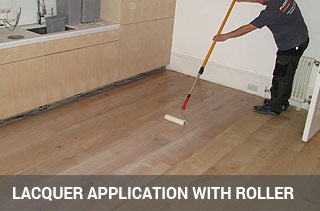Back to Flooring Products
Wood Floor Finishes & Application
 Choosing the right wood floor sealant is one of the most important steps in ensuring the durability and beauty of your flooring. Today’s market offers a wide range of products, but with years of professional experience, we know how to identify the most hard-wearing, eco-friendly, and easy-to-apply varnishes that deliver long-lasting results.
Choosing the right wood floor sealant is one of the most important steps in ensuring the durability and beauty of your flooring. Today’s market offers a wide range of products, but with years of professional experience, we know how to identify the most hard-wearing, eco-friendly, and easy-to-apply varnishes that deliver long-lasting results.
Floor Lacquers
Lacquers create a strong protective film on top of the wood, making them one of the most durable and low-maintenance finishes available. They are especially popular for busy households and commercial spaces where longevity is key.
At FlooringFirst!, we use mainly water-based lacquers with low VOC content and no harmful solvents, ensuring a safe and eco-friendly finish. Here are their main advantages:
- Fast drying: Only about 1 hour is needed between coats, with up to 3 coats applied in a single day.
- Quick usability: Floors can handle light foot traffic just 2 hours after the final coat, and furniture can be returned after 12 hours.
- Durable protection: Professional-grade, hard-wearing lacquers not available in retail shops.
- Flexible application: Can be applied with rollers for speed, as well as brushes or paint pads for precision.
- Choice of finish: Available in ExtraMatt, Matt, Satin, and Gloss sheens, giving clients full control over the final look.
Pro Tip: Choosing a lower sheen like ExtraMatt or Matt helps hide small scratches and dust, while Gloss provides a striking, reflective look but requires more frequent cleaning.
Oils & Hardwax Oils
Oils and hardwax oils penetrate deep into the timber rather than forming a film on top. This highlights the natural wood grain and texture, creating a warm, authentic look that many homeowners prefer. Unlike lacquers, oils nourish the wood from within, providing both protection and character.
- Drying time: Slower than lacquers, but usually only 2 coats are required, allowing most floors to be sealed within a single day.
- Repair-friendly: Scratches and scuffs can be easily spot-repaired without sanding the entire floor.
- Flexible application: Can be applied with rollers or brushes for a consistent finish.
- Choice of sheen: Available in Matt, Satin, and Gloss, offering different looks to suit any interior.
We use only trusted, professional-grade oils, including Osmo, Blanchon, Woca, Fiddes, and the innovative Rubio Monocoat single-coat system, known for its efficiency and durability.
Warning: Oil finishes require regular maintenance with the correct cleaning products. Using harsh detergents or too much water can break down the oil and leave the wood unprotected.
How Many Coats?
The number of coats applied depends on the type of finish and the level of protection required. At FlooringFirst!, we always aim to balance durability with a flawless look.
Lacquer Finishes
Our standard lacquer system includes 1 coat of primer followed by 2 coats of hard-wearing lacquer. In some cases, we run special promotions offering 3 coats, and for commercial projects, we typically recommend 3 full coats to withstand heavy traffic.
Oil-Based Finishes
When using oils or hardwax oils, we normally apply 2 coats. Because of the slower drying time and the way oils penetrate the timber, this is usually enough to achieve excellent protection and a beautiful finish. To keep the surface in top condition, a recoat every 16–24 months is recommended, especially in high-use areas.
Good to Know: While lacquers last longer between recoats, oil finishes are easier to refresh without sanding. This makes them a great choice for homeowners who prefer low-disruption maintenance.
Drying Time Factors
The drying time of a water-based finish depends on several environmental conditions. Understanding these factors helps ensure the best results and prevents damage to your newly finished floor.
- Humidity: Higher humidity levels slow down the drying process. On very humid days, varnish may take significantly longer to cure.
- Temperature: Warm rooms speed up drying. Turning on the heating an hour before varnishing on cold days can noticeably reduce drying time.
- Ventilation: Proper air circulation is essential. Keeping windows and doors open (weather permitting) helps finishes dry faster. Our team also uses professional airflow equipment to accelerate the process safely. Just remember: rain or excess moisture can seriously damage a freshly finished floor.
Pro Tip: Always allow the floor to dry completely before stepping on it or moving furniture back. Even if the surface feels dry to the touch, full curing may take longer, especially in cooler or more humid conditions.
Application
For the best results, we rely on natural light during the application process to ensure every detail of your floor is finished to perfection. This is why we prefer to start work as early as possible, always making sure not to disrupt your daily routine.
When varnish is applied to timber, the wood grain can rise slightly, leaving the surface feeling rough. To achieve a flawless finish, a final stage of fine floor sanding is carried out before the last coat is applied. This step guarantees a perfectly smooth and even surface, enhancing both the look and durability of your flooring.
Wood Floor Products Used by FlooringFirst! Services
At FlooringFirst!, we believe that the quality of the products we use is just as important as the skills of our craftsmen. That’s why all our wood floor sealing services are carried out with professional-grade finishes that ensure durability, safety, and a beautiful appearance.
You can explore the full list of wood floor products we use here ».